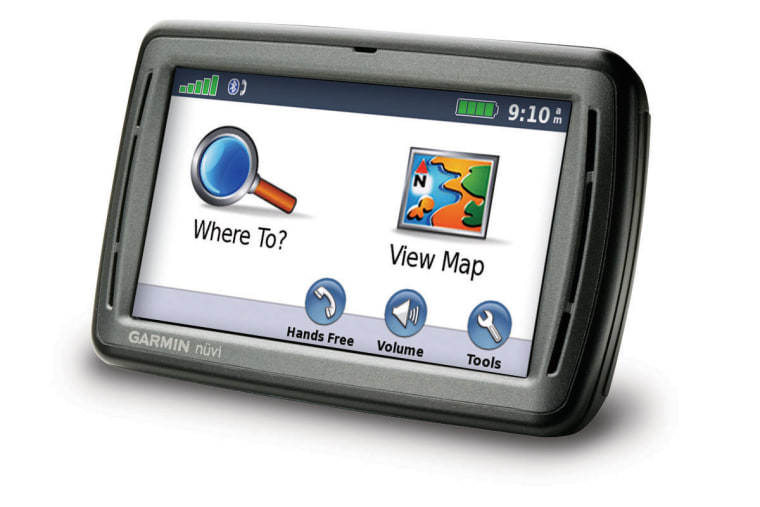Even with gas prices climbing to unprecedented heights, Americans are still going to hit the road this summer, some starting with Memorial Day weekend.
Having driven cross-country from Florida to California for grad school, I had a buddy along with me to keep me from nodding off. But it also would have been good to have something like Drive Alert Master ($24), which I found at VacationGadgets.com.
It’s a device that fits behind the ear — like a hands-free earpiece — and sounds a loud alarm if a driver starts nodding off. The cheaper Nap Zapper ($12), worn the same way, also emits a loud sound if an owner’s head dips below a certain angle.
I’m also a fan of portable GPS units. I say portable, mostly because I don’t need another gadget in the car that might break, however cool it looks. And, it’s nice to be able to take the unit with you for use in other people’s vehicles or rental cars.
I was introduced to one brand, TomTom, portable GPS devices last year. While the gimmick of hearing the directions through one of the celebrity voices is a good one — it’s never failed to amuse me when John Cleese says, “Bear Right. Beaver Left,” — what really counts is if it works.
Right now, there are several GPS devices that keep up with map changes by connecting to the home computer via a USB cable, getting online and downloading the latest information — including input from other eyes on the road, other drivers who are plugging in things they’ve observed on the road.
GPS units cost between $200 and $500, but can run close to $1,000 for the fully-loaded and newer models.
This summer’s crop may give you the latest in amenities, including those units that link up wirelessly to the car's FM stereo, satellite radio systems or even to a mobile phone to give you updates in construction activity, traffic accidents and other obstacles that keep you from getting from A to B in the real world.
That’s good information to have, as opposed to the world of the online MapQuest and Google Maps, which don’t always take into account the unexpected.
TomTom's GO 930 ($500) includes features such as IQ Routes, "which finds the most efficient route from point A to point B on weekdays versus weekends, and the Fuel Price feature which finds the gas stations with the cheapest gas in a 30-mile radius," said Jocelyn Vigreux, TomTom Inc. president.
Garmin, a leading manufacturer of GPS units, has the MSN Direct Receiver ($125) from Microsoft that plugs into your vehicle’s power outlet, and a compatible Garmin device. (Msnbc.com is a joint venture of Microsoft and NBC Universal.)
This receiver gives you real time information — local weather, traffic — even gas prices from MSN Direct. Service is free the first year.

The nine GPS units compatible with it mostly share the same characteristics: pre-loaded maps, big displays (4.3 inches), voice recognition (allowing hands-free communication between you and the unit), Bluetooth capability with your phone (again, for hands-free communication), the capability to tell you where the nearest hospitals and police stations are in case of emergencies and wireless FM transmitter to route your MP3 player through the car’s stereo system.
Garmin’s nuvi product line, which works with the MSN Direct Receiver, features GPS units that are sleek and slim, the size of a deck of cards. Most have more than 6 million “points of interest” — places like restaurants, gas stations and ATMs — included in each unit.
Music on the beach or plane
There are a lot of things out there that claim to help make things easier while traveling. I see them and I think, “You’re going to look like a dork if you wear that,” or when I see some at the beach carry such gear, I think, “Why would they drag all that around?”
I like devices that serve more than one purpose, so the iPod speaker/cooler combo is very appealing to me.
The Chill Out Stereo Cooler Bag ($58) by Lifepop (formerly Lifepod) is getting a lot of traction on blogs, and for good reason: it’s compact. Not only does it hook up to an MP3 player, or a CD player, it has waterproof speakers and enough space for eight ice-cold 12-ounce cans. With several bright designs, you’re not going to lose this anytime soon. Web sites such as Dormbuys.com sells it.
If you take to the air this summer and are booked on Virgin America, you might go without one gadget: your MP3 player.
Why? Until recently, I was unfamiliar with VA’s free Red in-flight entertainment system. I didn’t have to take out my iPod once, as I played with the 9-inch touchscreen on the seatback in front of me, and created a playlist from the 240 artists available.
On the way to San Francisco, I played a list of songs from Aqualung, Arcade Fire and Bloc Party, among many, many other artists. On the way to Seattle, I went for a soul/R&B-influenced list that included Chris Brown, Billie Holiday, Aretha Franklin, Dixie Chicks and songs from “Dreamgirls.” What a trip.
I also typed part of this article on the plane on my laptop, and had the flight been longer, I would’ve been able to plug in my power adapter in the outlets located beneath each seat.
Too bad the satellite TV was conked out both ways. So far, JetBlue has been much more reliable in that department on my red-eye flights to New York.
